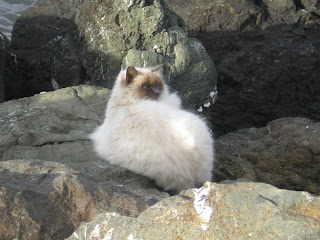On February 20, 2011 I met with Melissa Riofrio and asked her a few questions regarding the Homeless Cat Network and her involvement.
1) How long have you been with HCN? What do you do? How does it operate?
- Been with HCN for 5 1/2 years, currently on the board of directors.
- Initially got involved by bringing in some towels to help out.
- HCN started about 15 years ago, connected to Animal Control and the Peninsula Humane Society.
- Currently have about 250 volunteers.
- WANT TO EDUCATE PEOPLE... Make people become aware that the cats share the community with humans and that they SHOULD NOT be PENALIZED for being outside. It's not their fault!!
2) Where do you get the cats fixed/vet care?
- Take advantage of Peninsula Humane Society's (San Mateo County funded) voucher program. (http://www.peninsulahumanesociety.org/services/clinic.html)
- Very unusual program; not available everywhere.
- Sometimes will go to local vets (ex/ Coastal Cat Clinic in Pacifica)
3) Why do you do this? How did you get involved?
- Hopes that there will be a day/time when everyone knows how to care for a cat.
- Saw cats in need and wanted to help; COMPASSIONATE.
- Foster City has been a great advocate; Project Bay Cat along the Bay Trail next to San Mateo Bridge.
- Want to educate people who want to help but don't know how; don't support people who feed ferals but don't trap them and get them neutered.
4) What do you feel are some of the health issues/concerns related with ferals?
- Fleas, ticks, lice, ringworm, tapeworm = all transmittable to humans.
- Feces
- Upper respiratory (caused by stress)
- Feline distemper, Feline Leukemia = BAD
5) What's the best way for people to learn about colonies?
- Some are very visible.
- Volunteers visible and willing to explain what they're doing; communicating with the public is very important.
- DO NOT want locations of colonies openly available; each colony has one or more caretakers who monitor the health of the cats, as well as several feeders who take turns providing food and water.
- Afraid that some people might want to hurt the cats.
6) Do you feel that ferals are misunderstood/stereotyped? How about volunteers?
- YES; try everyday to minimize stereotype and educate.
- Engaging with the public important.
- Must present HCN well and professionally.
7) Why do you feel that more people don't volunteer?
- Worried about cost and disease.
- Don't know about TNR (trap-neuter-release)
- Most people just need a little push and are willing to help once they know how.
- Participate in local events and hold adoption fairs to create a presence to educate people about ferals and HCN.
- Couldn't find a website with information (which has recently been resolved by the creation of a new website)
8) How do you currently advertise and/or fund-raise?
- LOTS of little things.
- Newsletter; generates about 1/3 of HCN income per year
- Silent auctions
- Returning donors (some individuals donate lots of money).
- Currently working on getting grants.
- Fund-raising committee just formed.
- Social networking; currently is very limited and would like to explore this more.
- Want to get communities involved and educate.
- Want to move to modern day!
9) How do you feel about ASPCA commercials on TV/web? Are they effective? Would they be effective for HCN?
- Must work for them because they are a large organization with lots of money.
- HCN tries to be more upbeat and show success stories.
- Want to show people what can be done and how they can be part of that success; not on sadness.
- So far, staying upbeat has given them lots of results.
- Don't want people to feel overwhelmed or stressed.
10) Who would you like to see involved?
- EVERYONE!
- Anyone with any interest in helping cats.
- Kids; seem to naturally like animals and are open. Have gotten a lot of good responses from kids. Classes have been brought to HCN socialization center and have done school projects.
- Language barriers and low income neighborhoods are an issue.
- Hope that people will help educate each other within a community.
- More activity on the coast would be great; such a huge area to cover.


















Purpose Statement
The purpose of this study was to promote a method for educating the residents of Broadmoor regarding cat behaviors and responsible colony management to preserve and protect these animals.